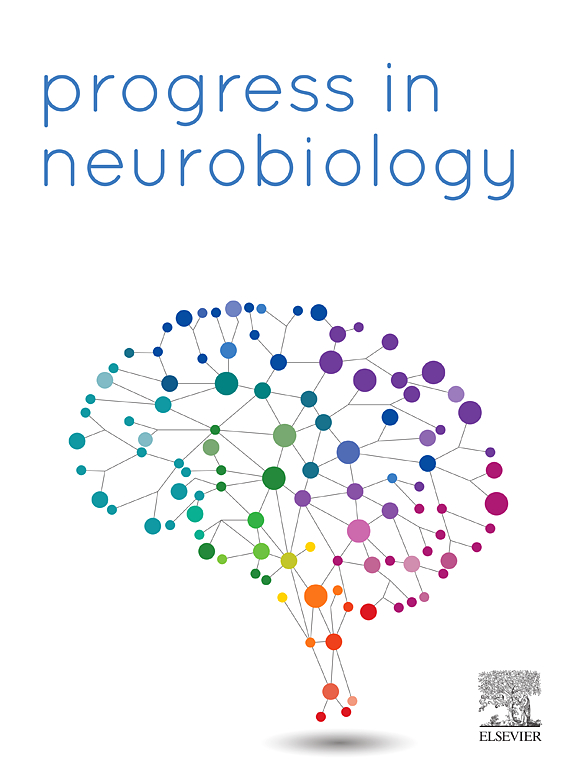Npas4驱动早期社会隔离对社会行为和前额叶小白蛋白神经元的影响。
IF 6.1
2区 医学
Q1 NEUROSCIENCES
引用次数: 0
摘要
社会行为在青少年时期趋于成熟。前额小白蛋白(PV)神经元在这一过程中发挥了关键作用,早期社会孤立导致其失调,导致成年期的社会缺陷。然而,早期社会隔离影响前额叶PV神经元导致社交障碍的分子机制尚不清楚。在这里,我们发现神经元特异性转录因子Npas4在这一过程中起关键作用。我们首先发现,社会隔离导致青少年前额叶皮层(PFC)中Npas4和PV表达的异常发育轨迹,导致Npas4的长期下调和PV的上调,这表明在早期社会隔离后,Npas4驱动的前额叶回路过度抑制。利用Npas4基因敲除(KO)小鼠和iDISCO全脑cFos图谱,我们进一步暗示了Npas4依赖性的前额叶活动减少与成年期社交能力缺陷的出现:我们在野生型小鼠从青春期过渡到成年期时观察到的Npas4 KO小鼠在社交能力和前扣带皮层(ACC)活动方面没有显示出年龄的增加。最后,利用病毒方法恢复青春期早期前额叶Npas4的表达,我们能够挽救由社会隔离引起的AAC的社交缺陷和PV的异常表达。总之,我们的研究结果通过Npas4在青春期前额叶PV神经元成熟中发挥的作用,确定了Npas4是早期社会隔离对社会缺陷的一种新的分子介质。本文章由计算机程序翻译,如有差异,请以英文原文为准。
Npas4 drives the effects of early social isolation on social behaviors and prefrontal parvalbumin neurons
Social behaviors mature during the adolescent period. Prefrontal parvalbumin (PV) neurons have been shown to play a critical role in this process, and their deregulation by early social isolation leads to social deficits in adulthood. However, the molecular mechanisms by which early social isolation affects prefrontal PV neurons causing social impairments remain unclear. Here, we identified the neuronal-specific transcription factor Npas4 as a key player in this process. We first showed that social isolation results in aberrant adolescent developmental trajectories of Npas4 and PV expression in the prefrontal cortex (PFC) leading to prolonged downregulation of Npas4 and upregulation of PV, suggesting an Npas4-driven over-inhibition of prefrontal circuits following early social isolation. Using Npas4 knockout (KO) mice and iDISCO whole brain cFos mapping, we then further implicated Npas4-dependent reduction in prefrontal activity with appearance of sociability deficits in adulthood: Npas4 KO mice failed to show an age-increase in sociability and in activity of the anterior cingulate cortex (ACC) that we observed in wild-type mice during the transition from adolescence to adulthood. Finally, using a viral approach to restore prefrontal Npas4 expression during early adolescence, we were able to rescue the sociability deficits and aberrant expression of PV in the AAC induced by social isolation. Altogether, our findings identified Npas4 as a novel molecular mediator of early social isolation on social deficits, through the role it plays on the adolescent maturation of prefrontal PV neurons.
求助全文
通过发布文献求助,成功后即可免费获取论文全文。
去求助
来源期刊

Progress in Neurobiology
医学-神经科学
CiteScore
12.80
自引率
1.50%
发文量
107
审稿时长
33 days
期刊介绍:
Progress in Neurobiology is an international journal that publishes groundbreaking original research, comprehensive review articles and opinion pieces written by leading researchers. The journal welcomes contributions from the broad field of neuroscience that apply neurophysiological, biochemical, pharmacological, molecular biological, anatomical, computational and behavioral analyses to problems of molecular, cellular, developmental, systems, and clinical neuroscience.
 求助内容:
求助内容: 应助结果提醒方式:
应助结果提醒方式:


